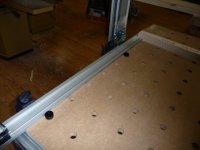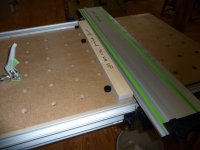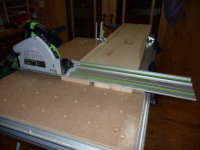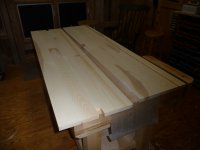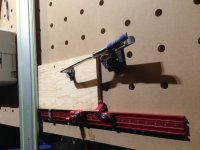My first post as a new Festool owner. In the last two months I have purchased the Festool TS55, the CT 36, the 1400 router, and the MFT/3. I have been woodworking for about 15 years, and I haven't smiled so much about using tools in a long time. Each Festool product has surprised me. Today I used the Tracksaw with the MFT for the first time and I accomplished something I have never done before.
I am working on a platform bed and today I tackled the 28" by 62" headboard. I glued up the boards in sections until I got to two 14" sections with oversized boards that I needed to square up.
Thanks to many suggestions from this forum and Paul Marcel's videos I went through a great process to setup my MFT. I bought an extra clamp for the back rail and used two clamps instead of the big protractor. With my precision dogs I set up the back rail and then set up the track at 90 degrees using another pair of dogs. Didn't even need a square with this method. I put the slop stop in the rail also. Then I did half a dozen test cuts to prove that I was getting true 90 degree cuts. Everything worked great.
My cross cut capacity on the MFT the way I had it set up was 27.5", so without making any modifications I decided to cut the two 14" sections individually. I marked lines on each board where I wanted to square them off. Then I accomplished something I haven't been able to do before - I cross cut a big board perfectly. I have used sleds before on my table saw and I always struggle keeping bigger boards square to the sled fence. Today with the board on the MFT against the fence and one clamp, probably not necessary, I made a perfect square cut. For those of you with tracksaws and the MFT that have done this hundreds of times I'm sure this is old hat. But today doing it for the first time I was just amazed how easy and accurate this was.
Then things got interesting. When I finished cutting the second board, another 14" by 62" section, my length was long by 1/32" since I was going off my pencil lines. I put it back on the MFT and tried to take off 1/32". I took my time setting the board up just proud of the clear splinter guard and then made my cut. Comparing this second board to the first board, I hadn't cut enough off. I had cut about 1/64". Back to the MFT for a second cut, and this time I got it. Twice I shaved about 1/64" off a 14" wide board with perfect 90 degree accuracy. I was blown away. This opens up a level of precision I never could have achieved before. With a good sled on the table saw I have to work hard to take off 1/16" and with a board this big and I usually can't make a straight cut.
Another big smile today that I just had to share.
I am working on a platform bed and today I tackled the 28" by 62" headboard. I glued up the boards in sections until I got to two 14" sections with oversized boards that I needed to square up.
Thanks to many suggestions from this forum and Paul Marcel's videos I went through a great process to setup my MFT. I bought an extra clamp for the back rail and used two clamps instead of the big protractor. With my precision dogs I set up the back rail and then set up the track at 90 degrees using another pair of dogs. Didn't even need a square with this method. I put the slop stop in the rail also. Then I did half a dozen test cuts to prove that I was getting true 90 degree cuts. Everything worked great.
My cross cut capacity on the MFT the way I had it set up was 27.5", so without making any modifications I decided to cut the two 14" sections individually. I marked lines on each board where I wanted to square them off. Then I accomplished something I haven't been able to do before - I cross cut a big board perfectly. I have used sleds before on my table saw and I always struggle keeping bigger boards square to the sled fence. Today with the board on the MFT against the fence and one clamp, probably not necessary, I made a perfect square cut. For those of you with tracksaws and the MFT that have done this hundreds of times I'm sure this is old hat. But today doing it for the first time I was just amazed how easy and accurate this was.
Then things got interesting. When I finished cutting the second board, another 14" by 62" section, my length was long by 1/32" since I was going off my pencil lines. I put it back on the MFT and tried to take off 1/32". I took my time setting the board up just proud of the clear splinter guard and then made my cut. Comparing this second board to the first board, I hadn't cut enough off. I had cut about 1/64". Back to the MFT for a second cut, and this time I got it. Twice I shaved about 1/64" off a 14" wide board with perfect 90 degree accuracy. I was blown away. This opens up a level of precision I never could have achieved before. With a good sled on the table saw I have to work hard to take off 1/16" and with a board this big and I usually can't make a straight cut.
Another big smile today that I just had to share.

